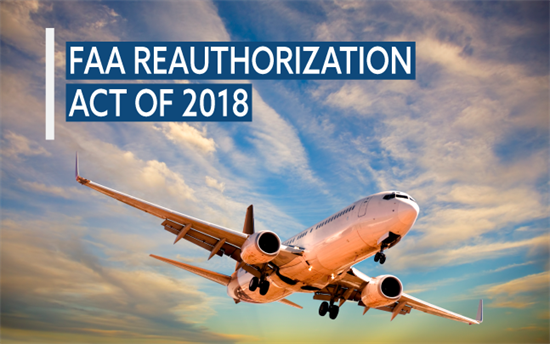Press Releases
House Overwhelmingly Passes Long-Term FAA Reauthorization BillBy a vote of 393 to 13, the House of Representatives today approved the bipartisan FAA Reauthorization Act of 2018 (H.R. 4), a five-year bill to reauthorize the programs of the Federal Aviation Administration, provide much needed long-term stability for the Nation’s aviation community, authorize robust investment in U.S. airports, improve America’s competitiveness in the global aviation sector, strengthen passenger protections, and ensure the safety of the system for the traveling public. H.R. 4 will also help communities across the country better prepare for, respond to, recover from, and mitigate against disasters of all kinds. The bipartisan FEMA reforms included in Title VI of H.R. 4 – the Disaster Recovery Reform Act (DRRA) – will provide greater focus on pre-disaster mitigation in order to lessen the impacts of future disasters, saving lines and saving taxpayer dollars. The legislation now goes to the Senate. More information about H.R. 4 can be found at the Committee’s pages on the FAA Reauthorization Act and the Disaster Recovery Reform Act. “Today, the House overwhelmingly approved the first long-term FAA reauthorization bill since 2012,” said Transportation and Infrastructure Committee Chairman Bill Shuster (R-PA). “While I would have liked this bill to have included the significant reforms to the management of the Nation’s air traffic control system I proposed in earlier legislation, H.R. 4 does include many other important reforms that will help job creators lead in a competitive global marketplace for aviation, improve our airport infrastructure in large, small and rural communities, and improve air travel for millions of Americans. “It is important to remember that this bill goes further than focusing only on aviation,” Shuster continued. “The bipartisan DRRA provisions included as part of H.R. 4 will ensure our communities are better prepared for the next hurricane, flood, or wildfire. By focusing on pre-disaster mitigation, DRRA shifts our disaster program mindset from reactive to proactive, which will save lives, save property, and save taxpayer dollars.” “Today’s passage of the first long-term FAA reauthorization package since 2012 shows the great bipartisan work that can get done in the Transportation and Infrastructure Committee. This legislation provides more than five years of stability for the FAA, improves aviation safety, and safeguards critical consumer protection aspects of air travel. I commend Chairman Shuster for his leadership in bringing this bill to the floor and look forward to working with our Senate colleagues to get this bill enacted before September,” said Transportation and Infrastructure Committee Ranking Member Peter DeFazio (D-OR). “This FAA authorization represents bipartisan cooperation and compromise to advance the Nation’s aviation interests and safety in the skies,” said Aviation Subcommittee Chairman Frank LoBiondo (R-NJ). “I share in the goal of strengthening our aviation system to meet 21st century demands while ensuring the FAA Technical Center in my South Jersey district has a leading role in this effort. Today the House sent a strong, bipartisan message that moving a five-year FAA bill through the Congress and sending it to the President’s desk this year will help ensure America maintains a safe, strong, and competitive aviation system.” “This has been a long time in coming,” said Aviation Subcommittee Ranking Member Rick Larsen (D-WA). “Congress has not enacted a long-term FAA reauthorization bill since 2012 and the agency is running on its fifth extension. With general aviation supporting more than 30,000 jobs in Washington state, this comprehensive, bipartisan bill provides long-term and predictable funding for the FAA, improves aviation safety, addresses workforce needs and advances vital research in the aviation field. This legislation ensures that the U.S. remains the gold standard in aviation. ” “We cannot afford to continue spending tens of billions of dollars on disasters like we did last year,” said Economic Development, Public Buildings, and Emergency Management Subcommittee Chairman Lou Barletta (R-PA). “It is critical that America have a better system in place that saves lives and taxpayer dollars when disaster strikes. The Disaster Recovery Reform Act will do just that and save the federal government $4 to $8 on the back end for every $1 spent on the front end. By passing this legislation for the second time, the House has made it clear that helping communities across the nation build better and build smarter by incentivizing pre-disaster mitigation is a top priority. I hope the Senate will agree and move quickly on this bill.” “This important legislation is the result of years of hard work,” said Economic Development, Public Buildings, and Emergency Management Subcommittee Ranking Member Dina Titus (D-NV). “The FAA Reauthorization contains a number of provisions that are critical for our economy, including language I championed to extend the authorization of Nevada’s Unmanned Aircraft System Test Range for an additional six years. This extension will allow the Nevada UAS Test Range to complete the important research being carried out in conjunction with the FAA and NASA on a low-altitude unmanned air traffic management system, which is vital to UAS commercial operations. The bill also includes my amendment to help large airports, like Las Vegas’s McCarran, advance important infrastructure projects and address our crumbling airport infrastructure. In addition, bill encompasses the bipartisan Disaster Recovery and Reform Act. DRRA contains commonsense, bipartisan reforms to help our communities not only respond to ever-worsening disasters caused by climate change, but prepare for them as well. As the devastating hurricanes and wildfires that impacted millions of Americans from the U.S. Virgin Islands to California have demonstrated, disasters are growing more violent and costly. We must prioritize pre-mitigation activities to make our communities more resilient and better-prepared for the next storm, fire, flood, and earthquake.”
|







